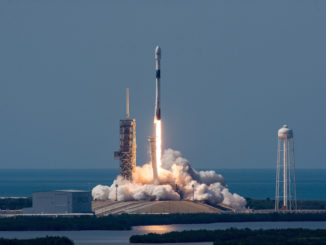A camera mounted on-board the upper stage of a Soyuz rocket launched Wednesday from South America captured dazzling views of the first six OneWeb broadband satellites separating from their carrier module more than 600 miles (about 1,000 kilometers) above Earth.
The video released by Arianespace shows the six 325-pound (147.7-kilogram) spacecraft, each about the size of a mini-refrigerator, separating from the Ruag Space dispenser following a one-hour launch sequence aboard a Soyuz rocket and Fregat upper stage.
The imagery first shows the jettison of the Soyuz rocket’s payload shroud a few minutes after liftoff from the European-operated Guiana Space Center in South America, followed by the release of two, then four, OneWeb satellites.
The dispenser was designed by Ruag Space in Sweden specifically for OneWeb satellites. There are 20 more Soyuz launches planned for OneWeb from French Guiana, Russia and Kazakhstan, each carrying 32 to 36 satellites to build out the company’s network providing worldwide broadband Internet coverage.
OneWeb plans to deploy 648 satellites in its initial constellation over the next two years.
On Wednesday’s launch, the dispenser carried four dummy mass simulators to replicate the weight of four additional OneWeb satellites. OneWeb opted to launch six spacecraft — not the originally planned 10 — on the demonstration mission, keeping four satellites on the ground as spares.
The mass simulators remained attached to the dispenser. The Fregat upper stage was scheduled to conduct a deorbit burn late Wednesday and re-enter the atmosphere, disposing of the spent rocket stage and the dispenser to avoid the creation of additional space junk.
The six craft placed into space Wednesday will next use their plasma thrusters to climb into their operational orbits 745 miles (1,200 kilometers) above Earth, where engineers will put the satellites through extensive checkouts before proceeding with further launches.
Read our full story for details on the mission.
Email the author.
Follow Stephen Clark on Twitter: @StephenClark1.



